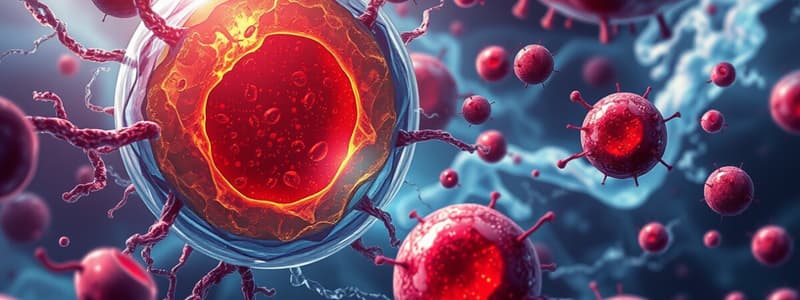Podcast
Questions and Answers
What is the primary effect of trans fats on cholesterol levels?
What is the primary effect of trans fats on cholesterol levels?
- They raise LDL levels and reduce HDL levels. (correct)
- They raise HDL levels significantly.
- They lower both LDL and HDL levels.
- They have no effect on cholesterol levels.
Which of the following describes the formation of trans fats?
Which of the following describes the formation of trans fats?
- They occur when saturated fats are oxidized.
- They are formed through complete hydrogenation of fatty acids.
- They are created when polyunsaturated fatty acids are partially hydrogenated. (correct)
- They form during the natural aging of oils.
What is the recommended maximum percentage of total calories that should come from trans fats?
What is the recommended maximum percentage of total calories that should come from trans fats?
- 2%
- 1% (correct)
- 10%
- 5%
In what configuration are most naturally occurring unsaturated fatty acids found?
In what configuration are most naturally occurring unsaturated fatty acids found?
Which risk factor is NOT mentioned as associated with premature coronary heart disease?
Which risk factor is NOT mentioned as associated with premature coronary heart disease?
What does a Framingham point score of at least 10-20% indicate?
What does a Framingham point score of at least 10-20% indicate?
What genetic inheritance pattern is associated with Cerebrotendinous Xanthomatosis?
What genetic inheritance pattern is associated with Cerebrotendinous Xanthomatosis?
Which compound's synthesis is decreased due to a deficiency in sterol 27-hydroxylase?
Which compound's synthesis is decreased due to a deficiency in sterol 27-hydroxylase?
If a patient has 0 to 1 risk factor, what classification do they fall under?
If a patient has 0 to 1 risk factor, what classification do they fall under?
Which procedure involves the use of an endoscope entering through the mouth to the duodenum?
Which procedure involves the use of an endoscope entering through the mouth to the duodenum?
How do trans fats affect LDL and HDL levels?
How do trans fats affect LDL and HDL levels?
In patients undergoing combination statin and cholestyramine therapy, which vitamin is particularly advised for supplementation before surgery?
In patients undergoing combination statin and cholestyramine therapy, which vitamin is particularly advised for supplementation before surgery?
What is a potential consequence of stasis of bile in the common duct?
What is a potential consequence of stasis of bile in the common duct?
What happens to the coated vesicles after they are internalized?
What happens to the coated vesicles after they are internalized?
What is released as a result of the fusion of lysosomes and endosomes?
What is released as a result of the fusion of lysosomes and endosomes?
Which major class of lipoproteins is produced in intestinal cells?
Which major class of lipoproteins is produced in intestinal cells?
What enzymatic activity does cholesteryl ester hydrolysis perform?
What enzymatic activity does cholesteryl ester hydrolysis perform?
How does free cholesterol affect cholesterol metabolism?
How does free cholesterol affect cholesterol metabolism?
What is the role of acyl CoA:cholesterol acyltransferase (ACAT) in cholesterol metabolism?
What is the role of acyl CoA:cholesterol acyltransferase (ACAT) in cholesterol metabolism?
Which statement correctly describes very-low-density lipoproteins (VLDLs)?
Which statement correctly describes very-low-density lipoproteins (VLDLs)?
What happens to the LDL receptor after the endosome-lysosome fusion?
What happens to the LDL receptor after the endosome-lysosome fusion?
What is the primary role of bile salts in fat digestion?
What is the primary role of bile salts in fat digestion?
Which component of bile salts interacts with fat during micelle formation?
Which component of bile salts interacts with fat during micelle formation?
What are the two secondary bile salts produced by bacterial enzymes in the intestine?
What are the two secondary bile salts produced by bacterial enzymes in the intestine?
How much bile salt does the body produce daily from cholesterol?
How much bile salt does the body produce daily from cholesterol?
What is a consequence of bile salts increasing the surface area of lipids?
What is a consequence of bile salts increasing the surface area of lipids?
What is the major product of cholesterol catabolism in the liver?
What is the major product of cholesterol catabolism in the liver?
Which mechanism allows fatty acids to be absorbed by the digestive system?
Which mechanism allows fatty acids to be absorbed by the digestive system?
What happens to bile salts after they perform their function in digestion?
What happens to bile salts after they perform their function in digestion?
What could explain the high circulating levels of LDL cholesterol despite normal levels of liver LDL receptor?
What could explain the high circulating levels of LDL cholesterol despite normal levels of liver LDL receptor?
In patients with high LDL levels, what initial treatment is recommended?
In patients with high LDL levels, what initial treatment is recommended?
Which blood pressure reading qualifies a patient as hypertensive in screening guidelines?
Which blood pressure reading qualifies a patient as hypertensive in screening guidelines?
What is a common side effect of statins in patients undergoing treatment for high LDL cholesterol?
What is a common side effect of statins in patients undergoing treatment for high LDL cholesterol?
Which of the following enzymes is important for the metabolism of triglycerides and may influence circulating cholesterol levels?
Which of the following enzymes is important for the metabolism of triglycerides and may influence circulating cholesterol levels?
Which patient group should undergo screening for dyslipidemia?
Which patient group should undergo screening for dyslipidemia?
What LDL target level is categorized as high risk for a patient with a history of myocardial infarction?
What LDL target level is categorized as high risk for a patient with a history of myocardial infarction?
What is the mechanism of action for statins in cholesterol management?
What is the mechanism of action for statins in cholesterol management?
Study Notes
Lipoprotein Metabolism
- Coated vesicles internalized by cells are known as endosomes after clathrin removal, fusing with lysosomes.
- Lysosomal proteases degrade apoproteins into amino acids; lysosomal enzymes hydrolyze cholesteryl esters into free cholesterol and fatty acids.
- Free cholesterol is released into the cytoplasm, available for cellular use or re-esterification by acyl-CoA:cholesterol acyltransferase (ACAT).
Major Classes of Lipoproteins
- Chylomicrons: Lowest density, transport dietary lipids from the intestine to target tissues. Produced from dietary lipids in intestinal cells.
- Very-Low-Density Lipoproteins (VLDLs): Synthesized in the liver, transport endogenously synthesized lipids.
Cholesterol Metabolism
- Free cholesterol impacts metabolism by inhibiting biosynthesis.
- Trans fats, created through partial hydrogenation of polyunsaturated fatty acids, raise LDL levels and lower HDL levels, posing health risks.
Risk Assessment for Coronary Heart Disease (CHD)
- Low Risk: 0 to 1 risk factor.
- Moderate Risk: 2+ risk factors and 10-20% Framingham point score for 10-year risk of CHD.
- High Risk: History of stroke, myocardial infarction, or diabetes.
Patient Case Analysis
- High LDL cholesterol with normal liver LDL receptor levels may indicate a mutation in apoprotein B-100 or other enzymatic issues affecting cholesterol metabolism.
Recommended LDL Target Levels
- Low Risk: <160 mg/dL
- Moderate Risk: <130 mg/dL
- High Risk: <100 mg/dL
Treatment Strategies
- First-line: Therapeutic lifestyle change (proper diet and exercise).
- Medication: Statins (e.g., atorvastatin, simvastatin, rosuvastatin), inhibiting HMG CoA reductase.
Screening Recommendations
- Start screening with a lipid profile for patients aged 45+, or younger if overweight, diabetic, hypertensive, or smokers.
- Fasting of at least 8 hours is required for lipid profile testing.
Bile Salts and Their Function
- Secreted by the gallbladder, bile salts emulsify fats for absorption.
- Generated from cholesterol catabolism in the liver; essential for forming micelles that aid in digestion.
Metabolism and Recycling of Bile Salts
- Approximately 400 mg of bile salts produced daily from cholesterol, with half of cholesterol utilized for metabolism.
- Intestinal bacteria convert primary bile salts to secondary forms, enhancing lipid digestion and absorption.
Clinical Procedures and Management
- ERCP (Endoscopic Retrograde Cholangiopancreatography) is used to remove stones from the bile duct, warrants caution due to infection risk.
- Prior to surgery, patients on statin and cholestyramine therapy should be advised to supplement with vitamin K, important for blood clotting functions.
Studying That Suits You
Use AI to generate personalized quizzes and flashcards to suit your learning preferences.
Related Documents
Description
Explore the process of endocytosis, where coated vesicles are internalized and transformed into endosomes. Learn about the role of clathrin in membrane-coated pits and how endosomes fuse with lysosomes for recycling cellular components.





